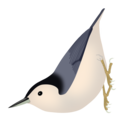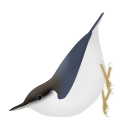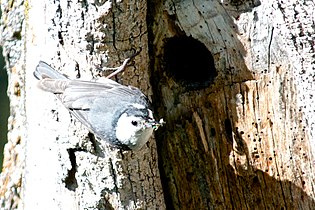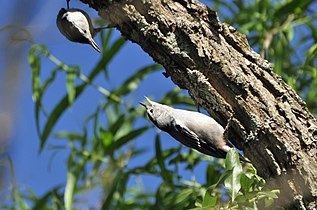White-breasted nuthatch
| White-breasted nuthatch | |
|---|---|

| |
| Adult male S. c. carolinensis in Green-Wood Cemetery, New York, USA | |
| Song of an individual from Wilkes County, North Carolina | |
| Scientific classification | |
| Domain: | Eukaryota |
| Kingdom: | Animalia |
| Phylum: | Chordata |
| Class: | Aves |
| Order: | Passeriformes |
| Family: | Sittidae |
| Genus: | Sitta |
| Species: | S. carolinensis
|
| Binomial name | |
| Sitta carolinensis Latham, 1790
| |

| |
| Approximate distribution map
Year-round
Nonbreeding
| |
The white-breasted nuthatch (Sitta carolinensis) is a
The white-breasted nuthatch breeds throughout much of
Taxonomy
The
Nuthatch taxonomy is complex, with geographically separated species sometimes closely resembling each other. The white-breasted nuthatch has an appearance and contact call similar to those of the white-cheeked nuthatch, of the
The simplified
| ||||||||||
| ||||||||||
Description
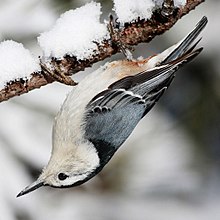
The white-breasted nuthatch is a medium-sized nuthatch, measuring about 15.5 cm (6.1 in) in length.[7] Like other members of its genus, it has a large head, short tail, short wings, a powerful bill and strong feet; it is 13–14 cm (5.1–5.5 in) long, with a wingspan of 20–27 cm (7.9–10.6 in) and a weight of 18–30 g (0.63–1.06 oz).[10]
The adult male of the
The female has, on average, a narrower black back band, slightly duller upperparts and buffer underparts than the male. Her cap may be gray, but many females have black caps and cannot be reliably distinguished from the male in the field. In the northeastern United States, at least 10% of females have black caps, but the proportion rises to 40–80% in the Rocky Mountains, Mexico and the southeastern U.S. Juveniles are similar to the adult, but duller plumaged.[7]
Three other, significantly smaller, nuthatches have ranges which overlap that of white-breasted, but none has white plumage completely surrounding the eye. Further distinctions are that the red-breasted nuthatch has a black eye line and reddish underparts, and the brown-headed and pygmy nuthatches each have a brown cap, and a white patch on the nape of the neck.[11]
Geographical variation
The white-breasted nuthatch has nine subspecies, although the differences are small and change gradually across the range. The subspecies are sometimes treated as three groups based on close similarities in morphology, habitat usage, and vocalizations. These groups cover eastern North America, the Great Basin and central Mexico, and the Pacific coastal regions.[11] The subspecies of the western interior have the darkest upperparts, and eastern S. c. carolinensis has the palest back.[7] The eastern form also has a thicker bill and broader dark cap stripe than the interior and Pacific races. The calls of the three groups differ, as described above.[11]
| Subspecies[7] | Range | Appearance |
|---|---|---|
| S. c. carolinensis | Nominate subspecies, northeast North America west to Saskatchewan and eastern Texas | Palest back and cap |
| S. c. nelsoni | Rocky Mountains, from northern Montana south to extreme northwest Chihuahua | Darker gray upperparts, darker cap, less contrast in wings |
| S. c. tenuissima | From British Columbia through the Cascade Range to southern California | Smaller than S. c. nelsoni, with slightly paler upperparts and a more slender bill |
| S. c. aculeata | Western parts of Washington, Oregon and California, northernmost Baja California. | Smaller than S. c. tenuissima, with buffer underparts, slightly paler upperparts and a more slender bill |
| S. c. alexandrae | Northern Baja California | Larger than S. c. aculeata, with marginally darker upperparts. The longest-billed race |
| S. c. lagunae | Southernmost Baja California | Smaller than S. c. alexandrae with slightly darker; underparts and more buff. Bill relatively stout |
| S. c. oberholseri | Southwest Texas and eastern Mexico | Very similar to S. c. nelsoni, but upperparts and underparts slightly darker |
| S. c. mexicana | Western Mexico | Duller than S. c. oberholseri with grayer flanks |
| S. c. kinneari | Southern Mexico in Guerrero and Oaxaca | Smallest subspecies, similar to S. c. mexicana but female has more extensively orange-buff underparts. Short, stout bill |
Similar species
Only three other species of nuthatches inhabit North America: the red-breasted nuthatch (S. canadensis), the pygmy nuthatch (S. pygmaea) and the brown-headed nuthatch (S. pusilla), and their distributions overlap with those of the white-breasted nuthatch. They are, however, clearly distinct and much smaller, since they are the smallest nuthatches, measuring 10 centimeters long and weighing around 10 grams.[12] The red-breasted nuthatch has reddish underparts and has a black stripe on the eye. The pygmy nuthatch and the brown-headed nuthatch have a brown crown with a white spot on the nape.[11]
- Nuthatches of North America
-
White-breasted nuthatch (S. carolinensis)
-
Red-breasted nuthatch (S. canadensis)
-
Pygmy nuthatch (S. pygmaea)
-
Brown-headed nuthatch (S. pusilla)
Distribution and habitat

The breeding habitat of the white-breasted nuthatch is woodland across
The presence of mature or decaying trees with holes suitable for nesting is essential, and trees such as oak, beech and hickory are favored in the east since they also provide edible seeds.[7] White-breasted nuthatches seldom excavate their own nest holes like red-breasted nuthatches.[14] Although suitable habitat is distributed continentally, it is discontinuous. The separate populations of this non-migratory species have diverged to form distinct regional subspecies.[15]
The white-breasted nuthatch, like most of its genus, is non-migratory, and the adults normally stay in their territory year-round. There may be more noticeable dispersal due to seed failure or high reproductive success in some years,[16] and this species has occurred as a vagrant to Vancouver Island, Santa Cruz Island, and Bermuda. One bird landed on the RMS Queen Mary six hours' sailing east of New York City in October 1963.[7]
Ecology and behavior
The white-breasted nuthatch often travels with small
-
In flight
-
In flight, from above
-
In a threatening position
Breeding
The white-breasted nuthatch is monogamous, and pairs form following a courtship in which the male bows to the female, spreading his tail and drooping his wings while swaying back and forth; he also feeds her morsels of food.[16] The pair establish a territory of 0.1–0.15 km2 (25–37 acres) in woodland, and up to 0.2 km2 (49 acres) in semi-wooded habitats, and then remain together year-round until one partner dies or disappears.[18] The nest cavity is usually a natural hole in a decaying tree, sometimes an old woodpecker nest.[7]
The nest hole is usually 3–12 m (9.8–39.4 ft) high in a tree and is lined with fur, fine grass, and shredded bark. The clutch is 5 to 9 eggs which are creamy-white, speckled with reddish brown, and average 19 mm × 14 mm (0.75 in × 0.55 in) in size. The eggs are incubated by the female for 13 to 14 days prior to hatching, and the
-
An adult at the entrance of the nest, an insect in the beak
-
An adult at nest entrance, feeding its nestlings
-
An adult removing a fecal sac from the nest
-
An adult preparing to feed its young
Voice
Like other nuthatches, the white-breasted nuthatch is a noisy bird with a range of vocalizations. The male's mating song is a rapid nasal qui-qui-qui-qui-qui-qui-qui. The contact call between members of a pair, given most frequently in the fall and winter is a thin squeaky nit, uttered up to 30 times a minute. A more distinctive sound is a shrill kri repeated rapidly with mounting anxiety or excitement kri-kri-kri-kri-kri-kri-kri-kri; the Rocky Mountains and Great Basin subspecies have a higher, faster yididitititit call,[7] and Pacific birds a more nasal beeerf.[11]
Feeding

The white-breasted nuthatch forages along tree trunks and branches in a similar way to woodpeckers and treecreepers, but does not use its tail for additional support, instead progressing in jerky hops using its strong legs and feet. All nuthatches are distinctive when seeking food because they are able to descend tree trunks head-first and can hang upside-down beneath twigs and branches.[19][20]
The white-breasted nuthatch is
Predators and parasites
Predators of adult nuthatches include owls and
The white-breasted nuthatch's responses to predators may be linked to a reproductive strategy. A study compared the white-breasted nuthatch with the red-breasted nuthatch in terms of the willingness of males to feed incubating females on the nest when presented with models of predators. The models were of a sharp-shinned hawk, which hunts adult nuthatches, and a house wren, which destroys eggs.[25] The white-breasted nuthatch is shorter-lived than the red-breasted nuthatch, but has more young, and was found to respond more strongly to the egg predator, whereas the red-breasted showed greater concern with the hawk. This supports the theory that longer-lived species benefit from adult survival and future breeding opportunities, while birds with shorter life spans place more value on the survival of their larger broods.[25]
The white-breasted nuthatch can be a host for certain parasites such as the
Conservation status

The white-breasted nuthatch is a common species with a large range, estimated at 8,600,000 km2 (3,300,000 sq mi). Its total population is estimated at 10 million individuals, and there is evidence of an overall population increase, so it is not believed to approach either the size criterion (fewer than 10,000 mature individuals) or the population decline criterion (declining more than 30% in ten years or three generations) of the
The removal of dead trees from forests may cause problems locally for this species because it requires cavity sites for nesting; declines have been noted in Washington state, Florida, and more widely in the southeastern U.S. west to Texas. In contrast, the breeding range is expanding in Alberta, and numbers are increasing in the northeast due to regrown forest.[7][33][34] The white-breasted nuthatch is protected under the Migratory Bird Treaty Act of 1918, to which the three countries in which it occurs (Canada, Mexico, and the United States) are all signatories.[18]
References
- ^ . Retrieved 19 November 2021.
- ^ "white wagtail=5 November 2022". ebird.
- ^ "Nuthatch". Merriam-Webster Online Dictionary. Merriam-Webster Online. Retrieved 3 August 2008.
- ISBN 0-550-10185-3.
- ^ Latham, John (1790). Index Ornithologicus, sive Systema ornithologiae (in Latin). Vol. 1. London: Leigh & Sotheby. p. 262.
- OCLC 727646681.
- ^ ISBN 0-7136-3964-4.
- S2CID 8775100.
- ^ S2CID 17637707.
- ^ a b "White-breasted Nuthatch". Cornell Lab of Ornithology Bird Guide. Cornell Lab of Ornithology. 2003. Retrieved 3 August 2008.
- ^ ISBN 1-873403-98-4.
- ^ Harrap & Quinn 1996, pp. 130–133.
- ISBN 0-87417-080-X.
- ^ "All About Birds - White-breasted Nuthatch Life History - Nesting". Cornell Lab of Ornithology. Retrieved 18 December 2019.
- S2CID 25041554.
- ^ ISBN 0-8117-2899-4.
- JSTOR 4089392.
- ^ American Ornithologists' Union. 1–16
- ISBN 1-55297-777-3.
- .
- ^ Hamid, Abdul; Odell, Thomas M.; Katovich, Steven. "White Pine Weevil". Forest Insect & Disease Leaflet 21. U.S. Department of Agriculture Forest Service. Retrieved 5 August 2008.
- ISBN 0-87371-350-8.
- S2CID 33801350.
- JSTOR 4083981.
- ^ S2CID 13165711.
- PMID 1212636.
- doi:10.1139/z89-379.
- JSTOR 4079515.
- ^ Peters, Harold S. (April 1933). External parasites collected from banded birds (PDF). Vol. 4. Bird Banding. p. 68-75.
- ^ Peters, Harold S. (January 1936). A list of external parasites from birds of the eastern part of the United States (PDF). Vol. 7. Bird-Banding. p. 9-27.
- ^ Main, Andrew J.; Anderson, Kathleen S. (October 1970). The genera Ornithoica, Ornithomya, and Ornithoctona in Massachusetts (Diptera: Hippoboscidae) (PDF). Vol. 41. Bird-Banding. p. 300-306.
- JSTOR 1365405.
- ^ "White-breasted Nuthatch Sitta carolinensis" (PDF). Florida's breeding bird atlas: A collaborative study of Florida's birdlife. Florida Fish and Wildlife Conservation Commission. 2003. Retrieved 3 August 2008.
- ^ "White-breasted Nuthatch Sitta carolinensis". BirdWeb – Seattle Audubon's guide to the birds of Washington. Seattle Audubon Society. Retrieved 3 August 2008.
External links
- Explore Species: White-breasted Nuthatch at eBird (Cornell Lab of Ornithology)
- White-breasted Nuthatch – Sitta carolinensis – USGS Patuxent Bird Identification InfoCenter
- White-breasted Nuthatch photo gallery at VIREO (Drexel University)


